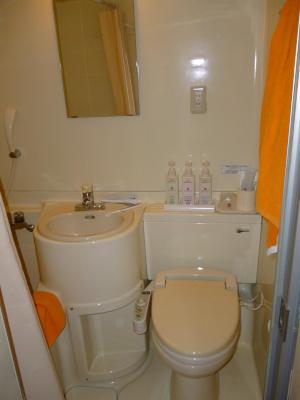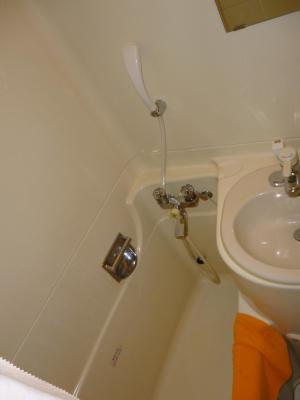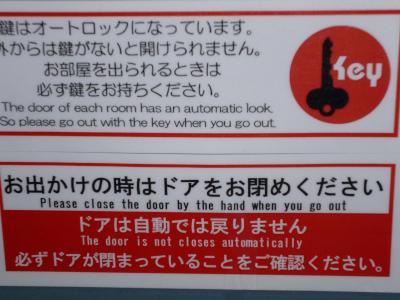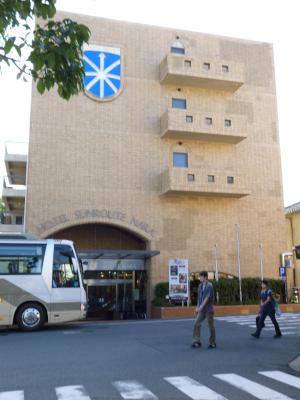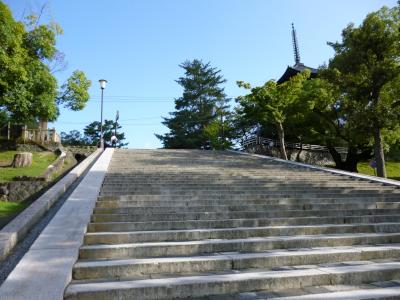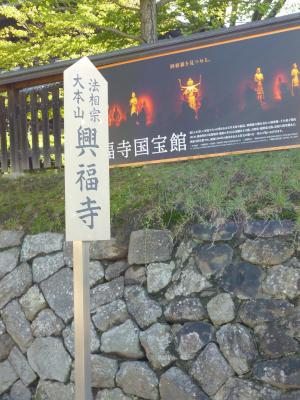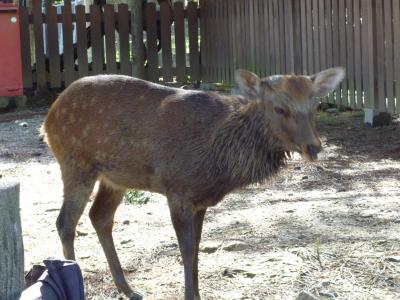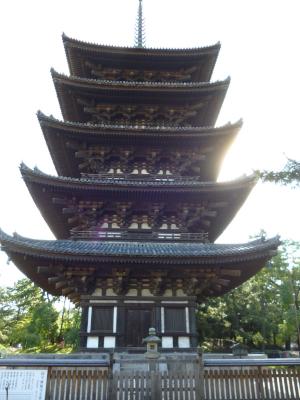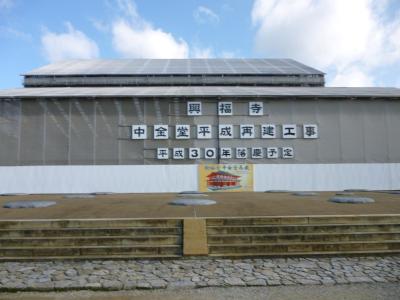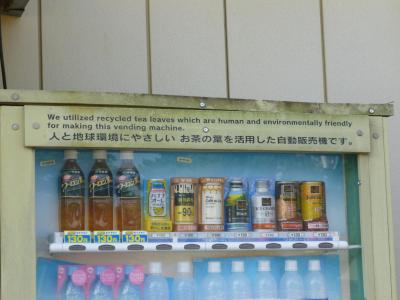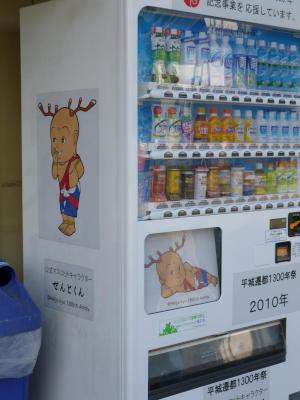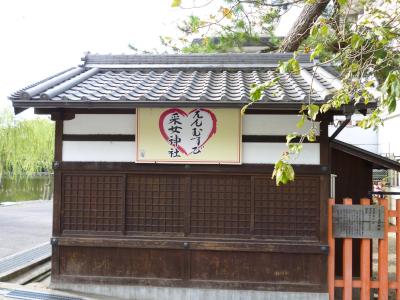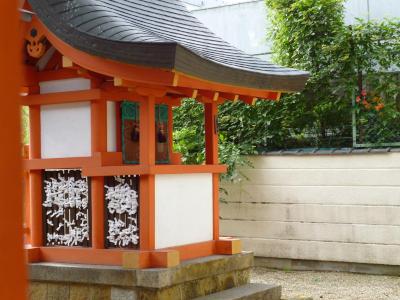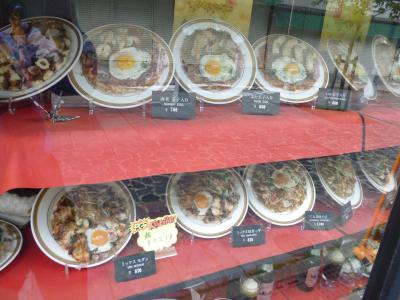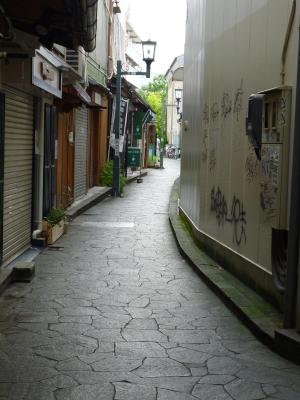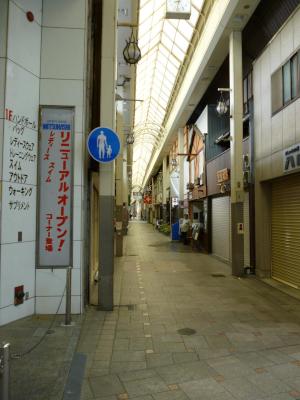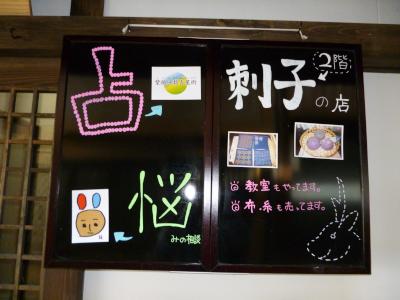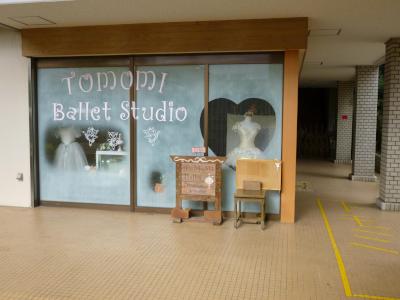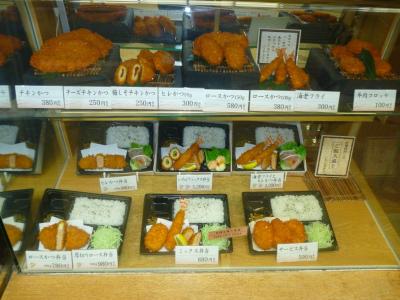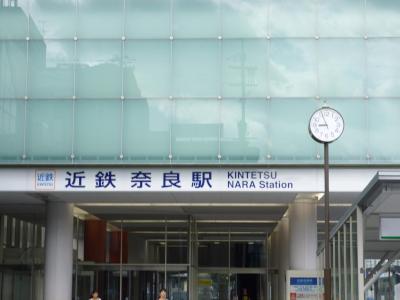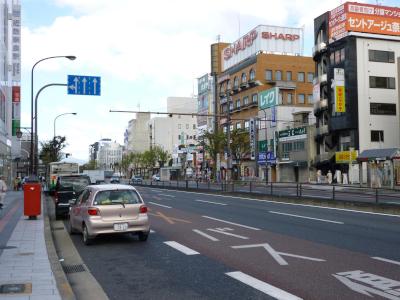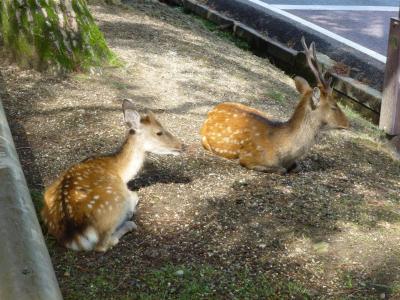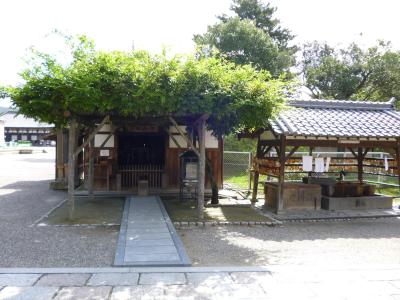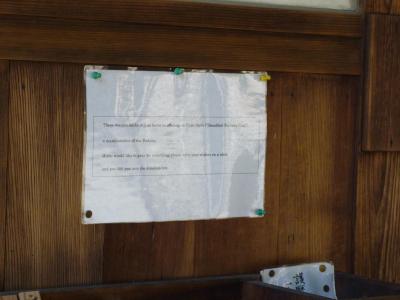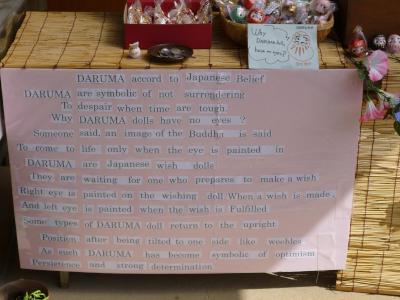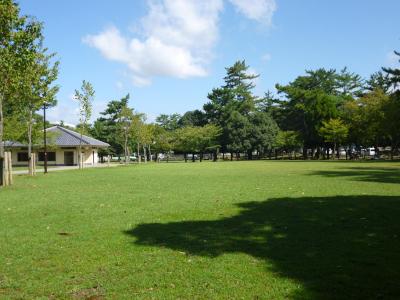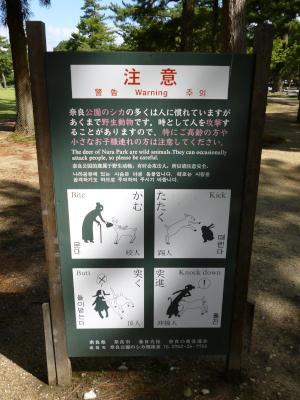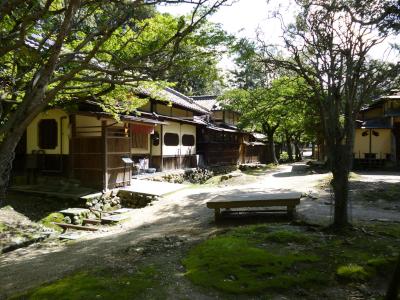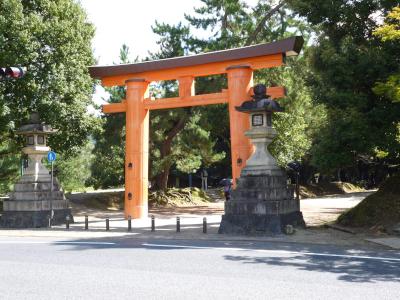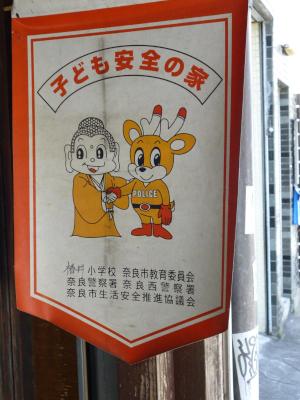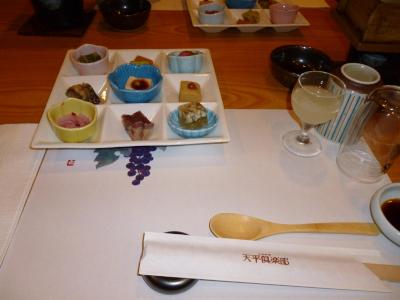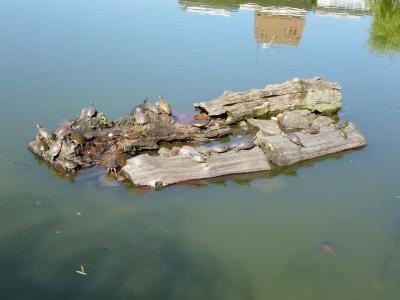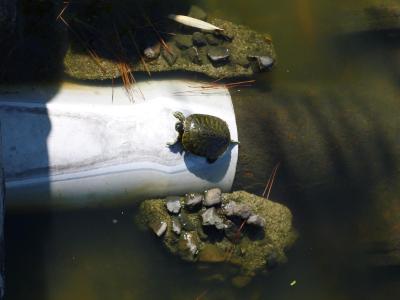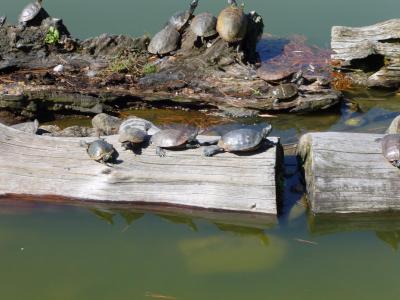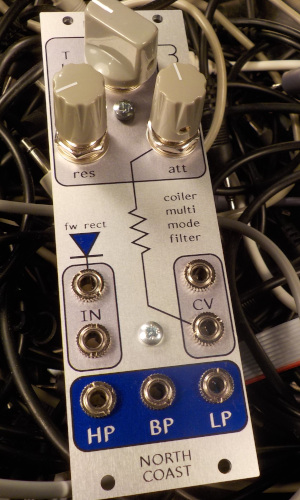Tuesday in Nara
Wed 7 Sep 2011 by mskala Tags used: travelSeptember 6 was the first day of MOL 12 - the workshop that is my excuse for coming to Japan in the first place. I'm not going to go into much detail on the conference itself, at least not right here; I did record the audio from my talk but I'm not even sure if I'll post it. I think it went okay, but I'm not sure I was really at the top of my game; some of my other conference talks have been better.
I got up pretty early and risked the hotel breakfast buffet, which turned out to be quite good. On some future day I'll take some photos of that; on Tuesday I concentrated on the park and city.
Roughly in the order of the photos: whereas hotels in the West often have coffee makers in the rooms, the equivalent amenity in a Japanese hotel is an induction heater for hot water, and a couple packets of green tea (お抹茶, o-matcha) powder. There are a couple of shots of the integrated bathroom unit. The inside of the hotel room door has a sign warning you that it's not on a spring and won't close by itself, so you must close it by hand - if you are too stupid to notice that the door is standing open, but still intelligent enough to read the sign. (In fact, the sign is a lie: the door does close by itself.)
From the hotel to the conference venue is just a short walk through the grounds of the Kofuku Ji (a Buddhist temple), 10 minutes or so if you don't stop along the way. I spent three hours making the trip, wandering all over the park and other parts of the city, and as a result I was so tired by the time I arrived at the conference, I had no energy for socializing and just sat and waited for the talks to start. Eventually the deputy conference organizer came over to make sure I was okay.
I think most of my commentary on the temple photos will wait until I get on a better Net connection and can spend some time looking things up to make sure I know which picture is which - I didn't make notes, my memory is only partial, and I wasn't always sure what I was looking at even at the time. There'll be a guided tour later which may clear some of it up. So I may go back and post explanations as comments in the gallery; go look for those if you're interested.
The park is full of deer, who are a Big Deal in Nara. They seemed less agressive than I've been warned, but nonetheless, there were plenty of signs up warning that the deer may bite you and you may not bite them back. (It's the same deal as with strippers.) To be precise, the deer will "Bite," "Kick," "Butt," and "Knock down" you. You can get cookies to feed them; I haven't tried that yet.
Many buildings at Kofuku Ji are designated national treasures. Probably the most famous one is the five-story pagoda, the second-highest pagoda in Japan. One thing I've noticed about these religious buildings - the Buddhist ones especially - is how big they feel. From a distance or on a map they may not seem unusual, but up close, it always feels like being in the presence of a mountain or something. I don't know if that's an energy thing or just clever architecture. (If, of course, there is a meaningful difference between those two explanations.)
It's also noteworthy that at least at this temple, even though it's theoretically a Buddhist facility, it's very Shinto in flavour. At a Shinto shrine you wash your hands, ring a bell, throw a coin, pray, and maybe buy a wooden plaque, write your prayer on that, and hang it on the rack. What I saw people doing at some of the Buddhist buildings on the Kofuku Ji grounds was: wash your hands, ring a gong, throw a coin, pray, and maybe buy a wooden stick, write your prayer on it, and leave it in the box to be burned. Of course there's also the whole thing of having actual Shinto shrines on the Buddhist temple grounds and vice versa - sometimes sharing staff between the two - which is typical at many sites in Japan. You know, just like how the average cathedral in the West has a couple of mosques in the basement.
See photos of 「えんむすび采女神社」 - which was closed when I took the photos, and I'm not sure how to pronounce some of those kanji (which I'd need in order to romanize the name; it's "Enmusubi (something) Jinja") - but I guess I can look that up later. The characters in the name mean "marriage-dice-woman-shrine." Note the heart shape on the sign. There are also signs up all over town advertising what seems to be the festival of that shrine, but it unfortunately seems to start on the 12th, the day after I will leave town.
Nara has several covered shopping streets full of tourist traps. These are aimed at domestic tourists (from elsewhere in Japan) much more than at people from further away, like me.
I've a photo of a sign explaining that "Some types of DARUMA doll return to the upright Position after being tilted to one side like weebles." Weebles? I was amazed that Weebl and Bob were known even here; but it turns out that actually, a "Weeble" is a kind of toy from the USA that was popular in the 1970s, from which Weebl probably got his name. I had not known that.
After wandering around for three hours, I went to the conference for the rest of the day. There were only three talks other than the invited ones, and mine was one of them. (A fourth had been scheduled but the speaker was unable to attend because of visa troubles.) Talks at this conference are being scheduled into 45-minute slots instead of the more usual 30-minute conference slots, so I had to write my talk a little longer than I otherwise would.
I was quite interested in an invited talk by a philosopher named Kit Fine about "truth-maker semantics," which discussed mathematical descriptions of just what sentences really mean. The technical details are very complicated, but I was pleased that I understood the talk better than I expected to. Some of it may be applicable to my own work. As a very simple example of the kinds of issues involved, consider the sentences "John ate an apple." and "John ate at least one apple." Under some simple theories of meaning, those two sentences have exactly the same meaning: one is true if and only if the other is true. But consider saying "John ate an apple and it was delicious." or "John ate at least one apple and it was delicious." One of those sounds really weird; why? The answer is that the two sentences we started with do not really mean the same thing; there's more to what a sentence means than just whether it might or might not be true. We need a more subtle way of expressing what "meaning" is.
At the end we had the conference banquet, which was lots of local specialties at a fancy traditional restaurant, but I only took one photo there, of a plate of nine kinds of fermented bean and seed products. Some of those were more palatable than others, but the overall banquet experience was very good. One dish I particularly liked was a thin slice of beef cooked at the table in a wooden steamer box - the waitress comes around and sets fire to a fuel pellet under it and then some minutes later you open the box and there's your onion-steamed beef slice. They also served good sake, a nice contrast to the bad sake I had not long ago in Canada.
I made it back to the hotel and into bed by about 10:30pm. I'm starting to get back onto a reasonable sleep/wake cycle.
Induction heater and tea set
Hotel Sunroute Nara bathroom
Hotel Sunroute Nara bathroom
Hotel Sunroute Nara
stairs to Kofuku Ji
name sign, Kofuku Ji
sacred deer, Nara
So this must be one of those bastards that trampled poor Tsukasa on the school trip to Kyoto and Nara. She must have ignored the signs about "Bite," "Kick," "Butt," and "Knock down" ...
Yeah. When I get back to Canada I'm going to have to watch that episode again and see how I like the "Nara narration."
five-story pagoda, Nara
Apparently, pagodas are constructed to honour the ashes of the physical body of the person the tour guide called "Historical Buddha," and at least in theory, a little bit of those ashes are buried under every one. This pagoda is the second-tallest in Japan.
new temple building under construction
The sign says the construction is due to be completed in Heisei year 30, which is 2019 Gregorian.
vending machine made from recycled tea leaves
vending machine with Horned Buddha
The sign at lower left identifies this being as "Sento-kun, the official mascot character of the [Nara City] 1300th anniversary."
temple sign, Nara
Kofuku Ji is the Buddhist temple; Nan'en Dou is the "Southern Octagonal Hall," a specific famous building that is part of the temple. Note "en" in Nan'en Dou, meaning "octagonal," is spelled 円, with the same character as the currency unit 円 (which is pronounced "yen" when referred to in English because of an historical spelling issue; the Japanese pronunciation is "en.")
Uneme Jinja
Uneme Jinja, informational sign
Uneme Jinja, shrine building
Photo taken through the fence; it was locked up when I visited. The slips of paper are unfavorable divination "fortunes," left behind at the shrine in order to leave behind the bad luck.
food display at restaurant
Nara 1300th anniversary mascot characters
Left: Manto-kun. Right: Sento-kun. Sento-kun is the official mascot chosen by the government; Manto-kun is a rival put forward by a coalition of local souvenir-shop owners, who objected that Sento-kun was insufficiently cute and would not sell well.
graffitti, very rare in Japan
shopping arcade, Nara
advertising sign, Nara shopping arcade
I took a picture of this to point out the character 占, which means "divination." It's a fairly advanced character (grade 8) despite being part of more common characters like 点 ("dot") and 店 ("shop"). The text indicated by the blue arrow seems to be advertising astrological services (占星従, senseijuu, characters meaning "divination star art.") I can't read the rest of the sign.
shopping arcade, Nara
pedestrian sign, Nara
Tomomi Ballet Studio
lanterns for Uneme Matsuri
Each one says "Uneme Matsuri," which is the festival of the Uneme Shrine.
food display, cutlet restaurant, Nara
Kintetsu Line train station, Nara
downtown Nara
sacred deer, Nara
sculpture, Nara Prefectural Office
shrine at Kofuku Ji
instruction sign, Kofuku Ji
weebles?
What this sign does not tell you is that "daruma" has another meaning. The women who approach you on the street at 2am in the scruffier neighbourhoods of Tokyo and ask "Daruma? Daruma?" are not selling dolls.
This just in: it turns out that the Japanese word for what we call a "snowman" is 雪だるま (yukidaruma, from "yuki" meaning "snow" plus "daruma").
Nara Park
bite, kick, butt, knock down
tea houses, Nara
torii, Kasuga Taisha
name sign, Kasuga Taisha
Fun fact: Kasuga is spelled the same way, 春日, in Kasuga Ayumu, which is the real name of the character in Azumanga Daioh whom everybody calls "Osaka."
child safety house
Something like a North American "Block Parent" sign. Title at the top says "child safety house." I think the text at the bottom is the list of names of sponsoring organizations.
This sign seems disturbing to me, possibly because the characters are looking away from each other. I get the impression that that Buddha has evil intentions toward the innocent and trusting police-deer.
start of MOL conference banquet
Nine kinds of moldy beans on a plate! And I didn't like any of them very much. Fortunately, the other courses of this fancy meal were more to my taste.
0 comments


